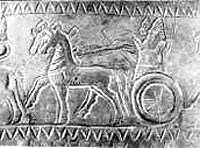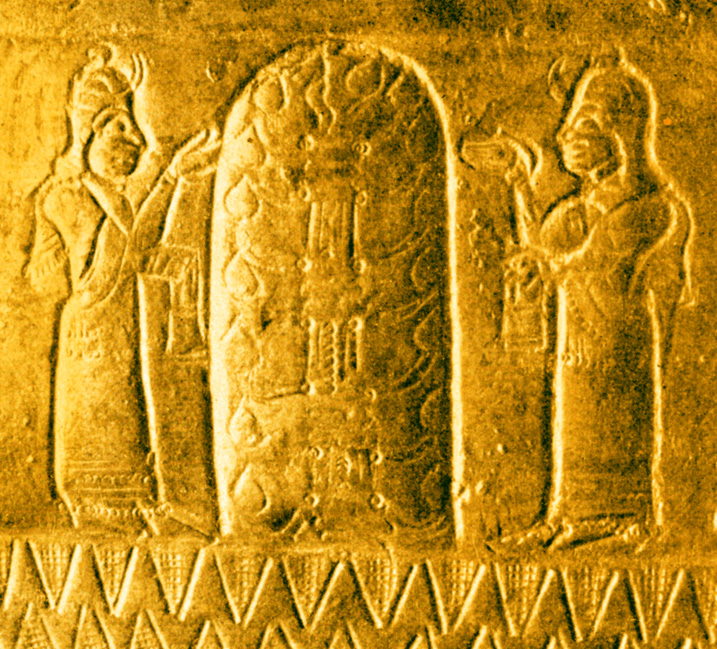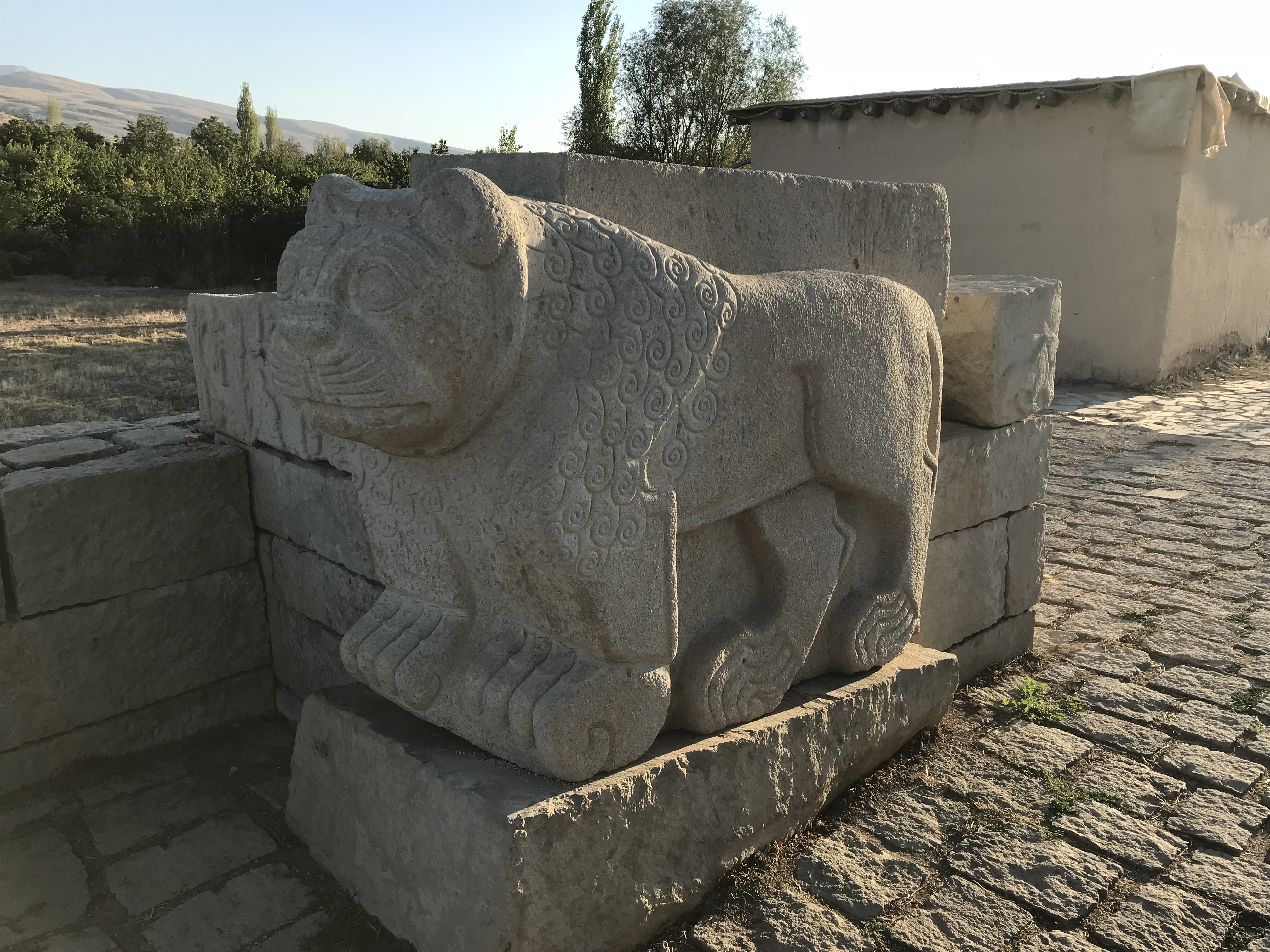|
Sarduri II
Sarduri II (ruled: 764–735 BC) was a King of Urartu, succeeding his father Argishti I to the throne. The Urartian Kingdom was at its peak during his reign, campaigning successfully against several neighbouring powers, including Assyria. The succession from Sarduri II is not entirely clear. There's also attested a king Sarduri III, so Rusa may also have been his son. Sarduri II notably expanded Urartian territory by conquering the northern region of Colchis, as well as Melid and Kummuh in the Euphrates valley. In 743 BC, at a battle located somewhere in Kummuh, the Assyrians, under Tiglath-pileser III, defeated Sarduri and his anti-Assyrian coalition, forcing the Urartians back across the Euphrates. Sarduri II was so confident in his power that he erected a massive wall at Tushpa (modern-day Van) with the following inscription: :"the magnificent king, the mighty king, king of the universe, king of the land of Nairi, a king having none equal to him, a shepherd to be wondered ... [...More Info...] [...Related Items...] OR: [Wikipedia] [Google] [Baidu] |
List Of Kings Of Urartu
This article lists the kings of Urartu (Ararat or Kingdom of Van), an Iron Age kingdom centered on Lake Van in eastern Asia Minor. Early kings *Arame (also Aramu, Arama) 858 BC–844 BC *Lutipri 844 BC–834 BC (?) Rise to power *Sarduri I (also Sarduris I, Sedur I, Asiduri I) 834 BC–828 BC; known in Assyrian sources as Ishtarduri, moved the capital to Tushpa, expanded the fortress of Van, possibly established new dynasty. * Ishpuini (also Ishpuinis, Ispuini) the Establisher 828 BC–810 BC; expanded the empire and conquered Musasir. *Menua (also Menuas, Minua) the Conqueror 810 BC–785 BC; initially ruled jointly with his father Ishpuini and later jointly ruled with his son, Inushpua, greatly expanded the kingdom, organized the centralized administrative structure, fortified a number of cities and founded fortresses, developed a national canal and irrigation system. *Inushpua 788–786 BC (?); co-ruled with his father, Menua. Possibly killed in battle. ... [...More Info...] [...Related Items...] OR: [Wikipedia] [Google] [Baidu] |
Argishti I Of Urartu
Argishti I (), was the sixth known king of Urartu, reigning from 786 BC to 764 BC. He founded the citadel of Erebuni in 782 BC, which is the present capital of Armenia, Yerevan. Alternate transliterations of the name include ''Argishtis'', ''Argisti'', ''Argišti'', and ''Argishtish''. Although the name is usually rendered as ''Argišti'' (read: ''Argishti''), some scholars argue that ''Argisti'' is the most likely pronunciation. This is due to the belief that the Urartians used the cuneiform symbol ''š'' to voice an ''s''-sound, as opposed to representing the digraph ''sh''. A son and the successor of Menua, he continued the series of conquests initiated by his predecessors, apparently campaigning every year of his reign. He was involved in a number of inconclusive conflicts with the Assyrian king Shalmaneser IV. He conquered the northern part of Syria and made Urartu the most powerful state in post- Hittite Asia Minor. He also expanded his kingdom north to Lake Sevan, conquering ... [...More Info...] [...Related Items...] OR: [Wikipedia] [Google] [Baidu] |
Rusa I
Rusa I (ruled: 735–714 BC) was a King of Urartu. He succeeded his father, king Sarduri II. His name is sometimes transliterated as ''Rusas'' or ''Rusha''. He was known to Assyrians as ''Ursa'' (which scholars have speculated is likely a more accurate pronunciation of the name) and possibly ''Urzana''. His birth name may have been ''Uedipri''. Rusa I built the fortress of Rusahinili (''Rusa-hinili'', city of Rusa), modern ''Toprakkale'', located near the modern city of Van in eastern Turkey. Background Before Rusa's reign had begun, his father, King Sarduri II, had already expanded the kingdom to southeastern Anatolia, and had managed to retake various Anatolian territories from Assyria during a brief period of weakness in the Assyrian Empire. The succession from Sarduri II is not entirely clear. There's also attested a king Sarduri III, so Rusa may have been his son. When Rusa I inherited the throne, the Assyrians continued campaigns against him. The Assyrian king Tiglat ... [...More Info...] [...Related Items...] OR: [Wikipedia] [Google] [Baidu] |
Sarduri II
Sarduri II (ruled: 764–735 BC) was a King of Urartu, succeeding his father Argishti I to the throne. The Urartian Kingdom was at its peak during his reign, campaigning successfully against several neighbouring powers, including Assyria. The succession from Sarduri II is not entirely clear. There's also attested a king Sarduri III, so Rusa may also have been his son. Sarduri II notably expanded Urartian territory by conquering the northern region of Colchis, as well as Melid and Kummuh in the Euphrates valley. In 743 BC, at a battle located somewhere in Kummuh, the Assyrians, under Tiglath-pileser III, defeated Sarduri and his anti-Assyrian coalition, forcing the Urartians back across the Euphrates. Sarduri II was so confident in his power that he erected a massive wall at Tushpa (modern-day Van) with the following inscription: :"the magnificent king, the mighty king, king of the universe, king of the land of Nairi, a king having none equal to him, a shepherd to be wondered ... [...More Info...] [...Related Items...] OR: [Wikipedia] [Google] [Baidu] |
Urartu 743-en
Urartu (; Assyrian: ',Eberhard Schrader, ''The Cuneiform inscriptions and the Old Testament'' (1885), p. 65. Babylonian: ''Urashtu'', he, אֲרָרָט ''Ararat'') is a geographical region and Iron Age kingdom also known as the Kingdom of Van, centered around Lake Van in the historic Armenian Highlands. The kingdom rose to power in the mid-9th century BC, but went into gradual decline and was eventually conquered by the Iranian Medes in the early 6th century BC. Since its re-discovery in the 19th century, Urartu, which is commonly believed to have been at least partially Armenian-speaking, has played a significant role in Armenian nationalism. Names and etymology Various names were given to the geographic region and the polity that emerged in the region. * Urartu/Ararat: The name ''Urartu'' ( hy, Ուրարտու; Assyrian: '; Babylonian: ''Urashtu''; he, אֲרָרָט ''Ararat'') comes from Assyrian sources. Shalmaneser I (1263–1234 BC) recorded a campaign in wh ... [...More Info...] [...Related Items...] OR: [Wikipedia] [Google] [Baidu] |
Monarch
A monarch is a head of stateWebster's II New College DictionarMonarch Houghton Mifflin. Boston. 2001. p. 707. Life tenure, for life or until abdication, and therefore the head of state of a monarchy. A monarch may exercise the highest authority and power in the Sovereign state, state, or others may wield that power on behalf of the monarch. Usually a monarch either personally inheritance, inherits the lawful right to exercise the state's sovereign rights (often referred to as ''the throne'' or ''the Crown, the crown'') or is elective monarchy, selected by an established process from a family or cohort eligible to provide the nation's monarch. Alternatively, an individual may self-proclaimed monarchy, proclaim themself monarch, which may be backed and Legitimacy (political), legitimated through acclamation, right of conquest or a combination of means. If a young child is crowned the monarch, then a regent is often appointed to govern until the monarch reaches the requisite adult a ... [...More Info...] [...Related Items...] OR: [Wikipedia] [Google] [Baidu] |
Urartu
Urartu (; Assyrian: ',Eberhard Schrader, ''The Cuneiform inscriptions and the Old Testament'' (1885), p. 65. Babylonian: ''Urashtu'', he, אֲרָרָט ''Ararat'') is a geographical region and Iron Age kingdom also known as the Kingdom of Van, centered around Lake Van in the historic Armenian Highlands. The kingdom rose to power in the mid-9th century BC, but went into gradual decline and was eventually conquered by the Iranian Medes in the early 6th century BC. Since its re-discovery in the 19th century, Urartu, which is commonly believed to have been at least partially Armenian-speaking, has played a significant role in Armenian nationalism. Names and etymology Various names were given to the geographic region and the polity that emerged in the region. * Urartu/Ararat: The name ''Urartu'' ( hy, Ուրարտու; Assyrian: '; Babylonian: ''Urashtu''; he, אֲרָרָט ''Ararat'') comes from Assyrian sources. Shalmaneser I (1263–1234 BC) recorded a campaign in wh ... [...More Info...] [...Related Items...] OR: [Wikipedia] [Google] [Baidu] |
Argishtis I Of Urartu
Argishti I (), was the sixth known king of Urartu, reigning from 786 BC to 764 BC. He founded the citadel of Erebuni in 782 BC, which is the present capital of Armenia, Yerevan. Alternate transliterations of the name include ''Argishtis'', ''Argisti'', ''Argišti'', and ''Argishtish''. Although the name is usually rendered as ''Argišti'' (read: ''Argishti''), some scholars argue that ''Argisti'' is the most likely pronunciation. This is due to the belief that the Urartians used the cuneiform symbol ''š'' to voice an ''s''-sound, as opposed to representing the digraph ''sh''. A son and the successor of Menua, he continued the series of conquests initiated by his predecessors, apparently campaigning every year of his reign. He was involved in a number of inconclusive conflicts with the Assyrian king Shalmaneser IV. He conquered the northern part of Syria and made Urartu the most powerful state in post- Hittite Asia Minor. He also expanded his kingdom north to Lake Sevan, conquerin ... [...More Info...] [...Related Items...] OR: [Wikipedia] [Google] [Baidu] |
Assyria
Assyria (Neo-Assyrian cuneiform: , romanized: ''māt Aššur''; syc, ܐܬܘܪ, ʾāthor) was a major ancient Mesopotamian civilization which existed as a city-state at times controlling regional territories in the indigenous lands of the Assyrians from the 21st century BC to the 14th century BC, then to a territorial state, and eventually an empire from the 14th century BC to the 7th century BC. Spanning from the early Bronze Age to the late Iron Age, modern historians typically divide ancient Assyrian history into the Early Assyrian ( 2600–2025 BC), Old Assyrian ( 2025–1364 BC), Middle Assyrian ( 1363–912 BC), Neo-Assyrian (911–609 BC) and post-imperial (609 BC– AD 630) periods, based on political events and gradual changes in language. Assur, the first Assyrian capital, was founded 2600 BC but there is no evidence yet discovered that the city was independent until the collapse of the Third Dynasty of Ur in the 21st century BC, when a line of independent kin ... [...More Info...] [...Related Items...] OR: [Wikipedia] [Google] [Baidu] |
Colchis
In Greco-Roman geography, Colchis (; ) was an exonym for the Georgian polity of Egrisi ( ka, ეგრისი) located on the coast of the Black Sea, centered in present-day western Georgia (country), Georgia. Its population, the Colchians are generally thought to have been an early Kartvelian languages, Kartvelian-speaking tribe ancestral to the contemporary western Georgians, namely Svans and Zans. According to David Marshall Lang: "one of the most important elements in the modern Georgian nation, the Colchians were probably established in the Caucasus by the Middle Bronze Age."''The Cambridge Ancient History'', John Anthony Crook, Elizabeth Rawson, p. 255 It has been described in modern scholarship as "the earliest Georgian formation", which, along with the Kingdom of Iberia, would later contribute significantly to the development of the Kingdom of Georgia and the Georgians, Georgian nation.Cyril Toumanoff, ''Studies in Christian Caucasian History'', pp. 69, 84Christopher ... [...More Info...] [...Related Items...] OR: [Wikipedia] [Google] [Baidu] |
Melid
Melid, also known as Arslantepe, was an ancient city on the Tohma River, a tributary of the upper Euphrates rising in the Taurus Mountains. It has been identified with the modern archaeological site of Arslantepe near Malatya, Turkey. It was named a UNESCO World Heritage Site under the name Arslantepe Mound on 26 July 2021. History Late Chalcolithic The earliest habitation at the site dates back to the Chalcolithic period. Arslantepe (VII) became important in this region in the Late Chalcolithic. A monumental area with a huge mudbrick building stood on top of a mound. This large building had wall decorations; its function is uncertain. Degirmentepe Değirmentepe, a site located 24 km northeast of Melid, is notable as the location of the earliest secure evidence of copper smelting. The site was built on a small natural outcrop in the flood plain about 40m from the Euphrates River. Early Bronze By the late Uruk period development had grown to include a large temple/pal ... [...More Info...] [...Related Items...] OR: [Wikipedia] [Google] [Baidu] |
Kummuh
Kummuh was an Iron Age Neo-Hittite kingdom located on the west bank of the Upper Euphrates within the eastern loop of the river between Melid and Carchemish. Assyrian sources refer to both the land and its capital city by the same name. The city is identified with the classical-period Samosata (modern-day Samsat Höyük), which has now been flooded under the waters of a newly built dam. Urartian sources refer to it as Kummaha. The name is also attested in at least one local royal inscription dating to the 8th century BCE. Other places that are mentioned in historical sources as lying within Kummuh are lands of Kištan and Halpi, and cities of Wita, Halpa, Parala, Sukiti and Sarita(?). Kummuh bordered the kingdoms of Melid to the north, Gurgum to the west and Carchemish to the south, while to the east it faced Assyria and later Urartu. Several indigenous rock inscriptions have been found in the region, all written in Hieroglyphic Luwian, attesting to the continuity of Hittite tr ... [...More Info...] [...Related Items...] OR: [Wikipedia] [Google] [Baidu] |




